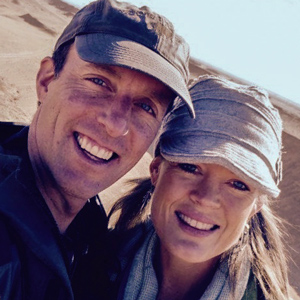Traveling the Eco-Friendly Way: On the Road with Ivana and Gianni
This is a traveler case study. (Read others or nominate yourself.)
Ivana Greslikova and Gianni Bianchini are two full-time travelers with a passion for eco-tourism. Here’s how they incorporate supporting conservation efforts in their travels:
Tell us about yourselves.
We are Ivana (from Slovakia) and Gianni (from Italy). While living in Germany, we decided to quit smoking. Our goal was to save money for a big trip, but we realized we’d be able to save enough for a Round-the-World experience.
What started as a one year plan became an indefinite journey. We are nature lovers, eco-travelers, and we’re passionate about photography. We try to immerse ourselves in the local culture while on the road.

What inspired you to start traveling?
Our break-up. We’d been dating long distance for a long time, and wanted to start new lives together in different countries.But seven years later we went on a trip to Morocco together and became a couple again. Ivana moved straight to Germany with one backpack and no German vocabulary to join Gianni.
Once back together and working regular jobs, we had an intensive feeling we were working more on someone’s else dreams rather than our own. So we wanted to explore the world.
Was there an ‘ah-ha’ moment that led you to focus on eco-traveling?
In Thailand, we were eager to ride an elephant. Instead of finding an agency online to book a pachyderm tour, we stumbled across several articles about animal abuse in the industry. Reading about cruelty inflicted upon elephants to train them to ride, we ended up shocked and almost in tears – and we dropped the idea immediately.
One month later, our friend Greg Goodman suggested we volunteer for Bring the Elephant Home, a foundation that cares for rescued elephants and restores their natural habitat. We helped them document their work with international schools from Bangkok and were hooked.
We did eventually pet an elephant during our days with Bring the Elephant Home. Their skin is rough and quite hairy, but their movements are very gentle and gazes so wise you feel like you are petting a giant who might just tell you something clever.
Ed note: If you’d like to get involved in helping elephants, read more here.

How do you learn what is eco-friendly and what is not?
Research. Many businesses greenwash—they use the term “eco” for their services in hopes of attracting customers, but often their activities are not eco-friendly. So, we are mindful of what we choose to do. We try to find local guides so we can support the local economy. We check eco-conscious travel blogs. Most importantly, we try to get first hand information from someone who has already been in the area.
It’s not always easy to be a discerning traveler. For example, tourists to Southeast Asia often visit villages where tribal women and kids stand waiting to have photos taken. Others choose to tour slums with heartbreaking poverty. Locals who became a human attraction see little to no money for the “performance” they do for paying tourists. It’s a vicious cycle.

What is a memorable experience you’ve had recently?
In the Philippines, we went to a local bistro in a small town of Pandan. We saw a cute little girl hiding behind the dishes in the kitchen, where her mother was working.
Diana was five, giggling and not speaking any language we knew. We liked her so much that we came back to the bistro again so we could speak with her mother.
We visited them later in their hut, demolished after hurricane Yolanda, and there was no electricity or running water. Diana was suffering from malnutrition. That’s why her mother took her to the bistro every day: so she could eat something. We asked the mother what she needed most and left her $30: this small sum was enough for an 18 month supply of vitamin C for Diane.
It was the first time we’d stood in front of the harsh reality of true hunger and poverty as travelers, not as readers. To walk on a garbage path to a house of someone you like and see that he or she is smiling despite all the tragedies that happened, we felt ashamed of the complaining we used to do before.

How do you pay for your travels?
After we quit smoking, we also quit drinking alcohol, which saved us a lot of money for our trip. Now, we work for ourselves as “Digital Nomads” sharing our stories through photography and our blog.
What is one thing you’ve learned that stands out?
There is always a story behind each facial expression or behavior from others, and it’s very immature to judge other cultures without knowing them better.

The great debate: aisle or window?
Depends on who is sleepier—that person gets the window.
Best travel tips. Go!
1. Call people by name.
Ask the name of the person you are speaking to, wherever you are, and remember it. Calling people by their name is one of the best things you can do to build trust.
2. You can never have too many motion-sickness pills.
When you pack for a cruise, or just a simple boat ride, and you are not sure whether you’ll get seasick, assume you will.
Where are you all headed next?
We plan to visit Myanmar, Vietnam, India, Mongolia and take the Interrail through Europe this year.
Read about Ivana and Gianni’s journey at Nomad is Beautiful or on Twitter @NomadBeautiful.
###







